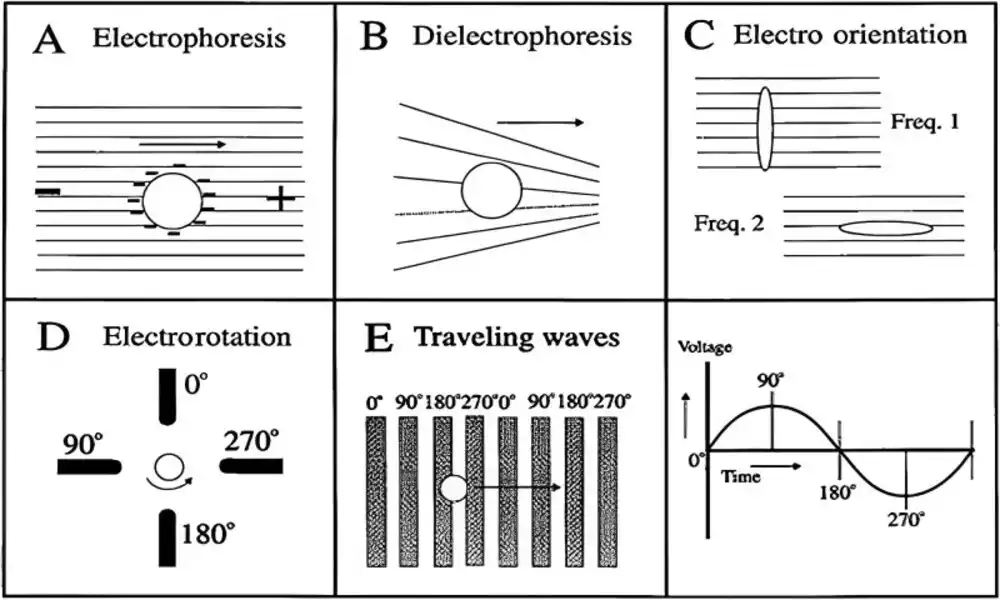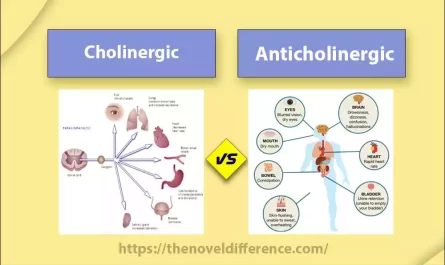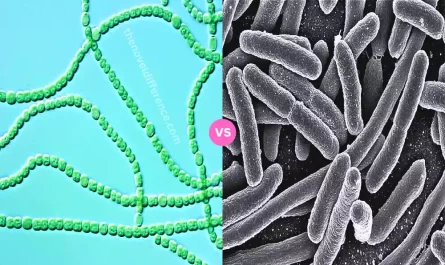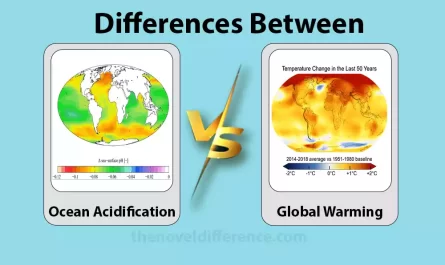Dielectrophoresis and electrophoresis are two key techniques utilized in biotechnology. Both of them depend on the movement of particles inside electrical fields to separate them or alter them. The underlying concepts of these techniques are very different.
Electrophoresis is the process of moving charged particles within an electric field. In contrast, dielectrophoresis is the process of moving neutral particles within a non-uniform electric field. This is the primary difference that forms the foundation of other differences between these two methods.
We will examine the primary differences between electrophoresis and dielectrophoresis as well as their uses as well as the different aspects that determine which method is best suited for a particular application.
Electrophoresis
Electrophoresis is a way to separate charged particles like proteins, DNA, and other tiny things based on their charge and size. It’s like getting them to move through a special goo or a tiny tube by using electricity.
Here’s the simple version:
- There’s this gel stuff that’s like jelly made from seaweed or this other material that acts as a tiny maze for the particles to move through.
- When you zap this gel with electricity, the charged particles start to move. The positively charged particles go one way, and the negatively charged ones go the other way.
- How it works depends on what you’re dealing with. For big stuff like DNA, there’s this agarose gel that works well. For smaller things like proteins, they use this other fancy gel called polyacrylamide.
- Another cool version of this is capillary electrophoresis, where they use a really thin tube instead of a gel. The particles move through the tube, and you can see them at the other end.
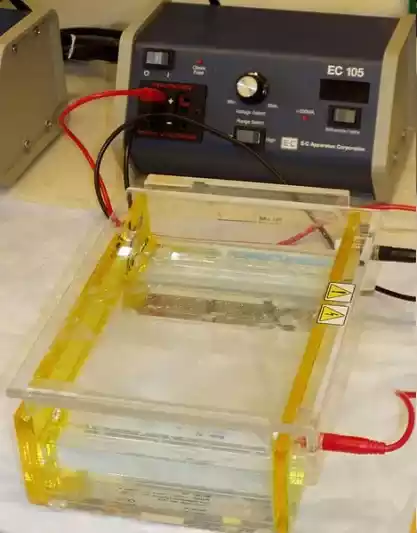
People use this stuff to do all sorts of things like understanding DNA, looking at proteins, solving crimes, and making sure things are clean and pure.
The Trick Behind Electrophoresis
The trick behind electrophoresis is getting these charged particles to move using electricity. Here’s the deal:
- Charged Stuff: Electrophoresis deals with things that have a bit of electrical charge, like DNA, proteins, and other tiny things you can find in living stuff.
- Electric Zap: When you turn on the electricity, these charged particles start to move because they feel this force. It’s like when you feel pushed by the wind when it’s blowing.
- Push and Pull: Depending on whether they’re positive or negative, these particles go in different directions. The positive ones move towards the negative side, and the negative ones move towards the positive side like they’re playing a game of catch.
- Sorting Things: The smaller and more charged particles move faster, and the bigger ones move slower. It’s like having a race where the little speedy guys zoom ahead, and the big ones take their time.
- Getting Results: By playing around with the stuff you use and how strong the electricity is, you can make these particles separate and then figure out what’s what. It’s like sorting your socks by color and size so you can find the perfect pair.
The trick is all about using electricity to make these charged particles move, and then watching them to learn all about them.
Techniques of Electrophoresis
Electrophoresis is a widely used technique in biochemistry and molecular biology for the separation and analysis of macromolecules such as nucleic acids and proteins. Various techniques have been developed to meet specific research needs.
Here are some common types of electrophoresis techniques:
- Agarose Gel Electrophoresis: This technique is commonly used for the separation of DNA fragments and RNA molecules. The molecules move through a gel matrix made of agarose, and their separation is based on size.
- Polyacrylamide Gel Electrophoresis (PAGE): PAGE is used for higher resolution separation of proteins and nucleic acids. It is often used for analyzing protein samples and resolving smaller DNA fragments.
- Two-Dimensional Gel Electrophoresis (2-DE): This technique combines isoelectric focusing (IEF) and SDS-PAGE to separate proteins based on both their charge and molecular weight. It allows for high-resolution separation of complex protein mixtures.
- Capillary Electrophoresis (CE): This technique utilizes narrow-bore capillaries and high voltage to separate molecules based on their charge and size. It is often used for analyzing DNA fragments, proteins, and small ions.
- Isoelectric Focusing (IEF): IEF separates proteins based on their isoelectric points, which is the pH at which the protein carries no net electrical charge. It is often used as the first dimension in two-dimensional gel electrophoresis.
- Pulsed-Field Gel Electrophoresis (PFGE): PFGE is used to separate large DNA fragments, such as those from whole genomes. It employs a specialized apparatus that alternates the direction of the electric field, allowing for the separation of large DNA fragments that cannot be resolved using standard gel electrophoresis.
These techniques have been crucial in various fields of research, including molecular biology, genetics, and biotechnology, enabling the separation and analysis of biomolecules with high precision and resolution.
Dielectrophoresis: A Simple Explanation
Dielectrophoresis, or “dep” for short, is a cool way to move tiny particles using electricity. It’s different from other methods because it works with particles that aren’t charged. Instead, it relies on the particles’ ability to change their shape when an electric field is around.
Here’s how it works in a super easy way:
- Special Particles: We use dielectrophoresis for particles that don’t have any electrical charge but can change their shape when we put an electric field near them. These particles can’t conduct electricity or don’t conduct it very well.
- Electric Field Trick: We create an electric field that isn’t the same all over. It’s like having a playground with hills and valleys, but instead of dirt, it’s an electric field. We do this by using a special kind of electricity called AC or DC.
- Shape Changing: When we put these special particles in our electric field playground, they start changing their shape. This change makes them move because they want to follow the electric field’s shape. It’s like if you’re on a rollercoaster and you lean one way, you go that way.
- Particle Adventure: The particles move around because of this special force we call dielectrophoretic force. They can go up or down, left or right, depending on how they react to the field. Think of it as their very own electric rollercoaster ride.
- Fun with Particles: We use dielectrophoresis to do cool things, like collecting particles together, sorting them out, or putting them where we want. It’s like playing with tiny building blocks that you can control with your electric magic.
Dielectrophoresis is used in lots of stuff like studying cells, making tiny gadgets, and doing experiments in labs. It’s great because we don’t have to touch the particles, we don’t need special labels, and we can use all kinds of different particles.
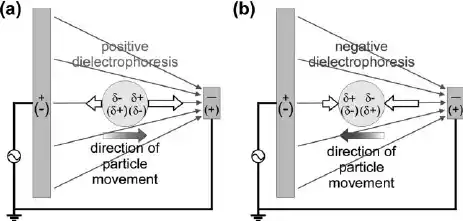
But, sometimes it can be tricky to use, especially with some particles that are good at conducting electricity, or when we want to be super precise. Scientists are still learning more about it to make it even better for different things.
Techniques of dielectrophoresis
- Positive DEP (PDEP): Imagine particles being drawn together by an invisible force when placed in an electric field. This happens in Positive DEP. It’s like magnets pulling particles closer when they are less conductive than the surroundings. Scientists can adjust the electric field’s strength and frequency to control and trap these particles where they want.
- Negative DEP (NDEP): In Negative DEP, particles are pushed away from each other when exposed to an electric field. This technique is used when particles are more conductive than their surroundings. Scientists can fine-tune the electric field to keep these particles away from certain areas, making it great for sorting them.
- Traveling Wave DEP (TWDEP): This is like a moving wave of electric force! Scientists create a wave that flows through a tiny channel or an array of electrodes. They can use this to keep particles in check, move them around, or separate them based on their properties. It’s like a particle dance!
- Frequency-Specific DEP (FSDEP): Imagine having a radio station for particles. With FSDEP, scientists use specific frequencies to target and manipulate particles based on their properties. They can select which particles to trap or repel by tuning the electric field’s frequency. It’s like a sorting mechanism!
- Electro-Rotation (Rot-DEP): This technique combines DEP with spinning particles. Scientists apply an electric field that makes particles rotate. By carefully controlling this electric field, they can align particles or make them spin at different speeds. It’s useful for various applications, like sorting or analyzing particles based on their rotation.
- Continuous Flow DEP (CF-DEP): Imagine a river where particles are like boats, and scientists control their flow. In CF-DEP, microfluidics and DEP join forces. Scientists use tiny electrodes in tiny channels to keep particles in check, sort them, or manipulate them while the fluid keeps moving.
These techniques are like tools in a scientist’s toolbox, and they can mix and match them for different tasks. DEP is like magic in the world of tiny particles, and it’s used in all sorts of cool stuff like sorting cells, separating particles, running lab tests, and more. Scientists are always coming up with new and exciting ways to use DEP, making it a never-ending journey of discovery!”
Key comparison chart of Electrophoresis and Dielectrophoresis
Here is a comparison chart between Electrophoresis and Dielectrophoresis:
| Parameters | Electrophoresis | Dielectrophoresis |
|---|---|---|
| Mechanism | Movement of charged particles in a fluid under the influence of an electric field. | Movement of polarizable particles in a non-uniform electric field. |
| Particle Type | Charged particles | Polarizable particles |
| Driving Force | Coulombic forces | Induced dipoles and polarization forces |
| Dependence on Charge | Depends on the magnitude of the charge on particles. | Not dependent on the magnitude of the charge. |
| Applied Field | Uniform electric field | Non-uniform electric field |
| Particle Behavior | Faster movement of highly charged particles. | Affected by the polarizability of the particle. |
| Applications | Separation and analysis of biomolecules such as proteins and nucleic acids. | Manipulation and separation of particles for bioanalysis, biomanipulation, and biomanipulation. |
| Limitations | Limited to charged particles | Limited to polarizable particles |
Understanding the Difference Between Electrophoresis and Dielectrophoresis
Understanding the differences between electrophoresis and dielectrophoresis is super important for a bunch of reasons:
- Where They Work: Both these techniques are used to handle particles in different areas like biology, chemistry, materials science, and microfluidics. Knowing how they differ helps you choose the right one for your specific job.
- How They Work: Electrophoresis makes charged particles move in an electric field, while dielectrophoresis deals with the movement of polarizable particles in a non-uniform electric field. Knowing this helps you understand how they do their thing and how to get the best out of them.
- Moving Particles: Electrophoresis is good for separating particles based on their charge and size, while dielectrophoresis can do more complex tricks like sorting, trapping, and assembling particles. Knowing this helps you plan cool experiments that do exactly what you want.
- Electric Field Stuff: Electrophoresis needs a steady electric field, but dielectrophoresis likes it a bit messy, with a non-uniform electric field. This is key in setting up your gear just right.
- What They’re Good For: Electrophoresis is often used in DNA and protein analysis, while dielectrophoresis is handy for playing with cells, trapping particles, and microfluidic systems. Knowing this helps you pick the right tool for your job.
- Pros and Cons: Electrophoresis is great for detailed separation, while dielectrophoresis lets you work without touching things or using labels. Knowing the good and bad points helps you pick what works best for you.
Understanding these differences helps you choose the right method, set up your experiments well, and get the results you need for all kinds of cool stuff.
Last opinions
Dielectrophoresis, as well as electrophoresis, comprise the two most important techniques that are used in biotechnology. Both methods rely on the motion of particles within an electric field, but their fundamental principles are different.
In deciding on the method to choose, many elements must be taken into account such as the size and charge of particles used, the intended result of the experiment, and the power of the field that is required.

